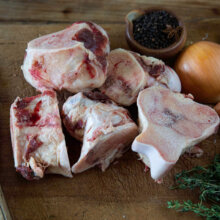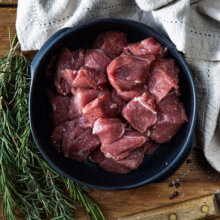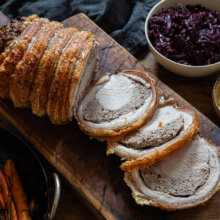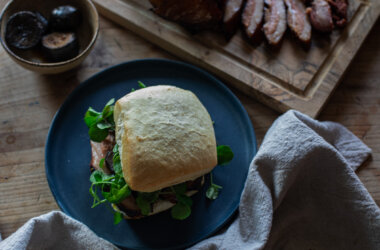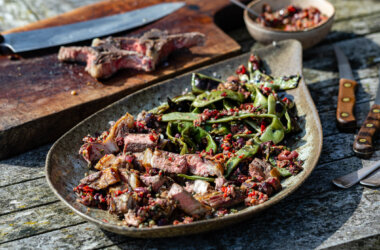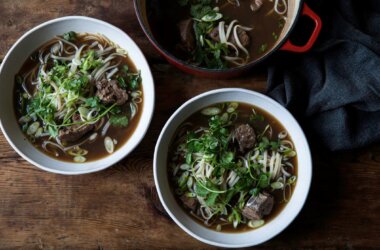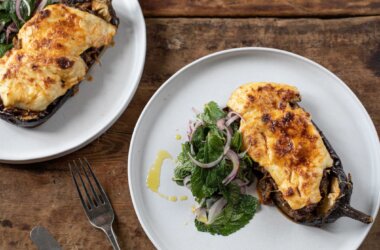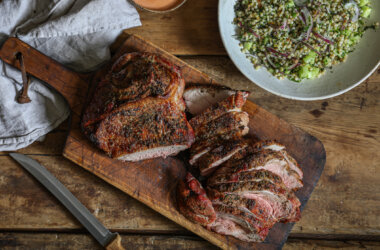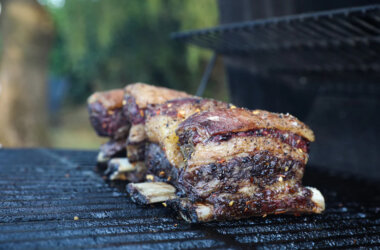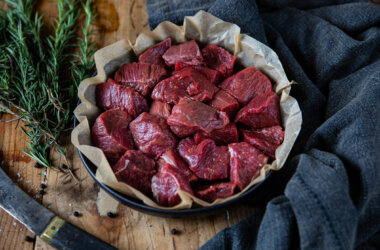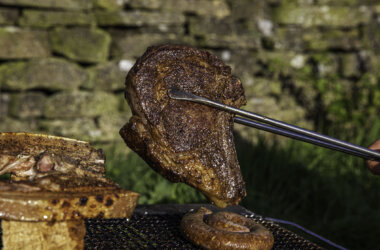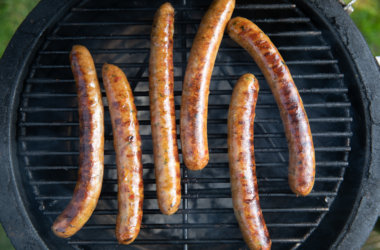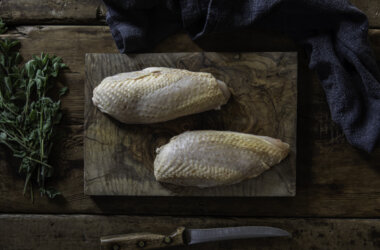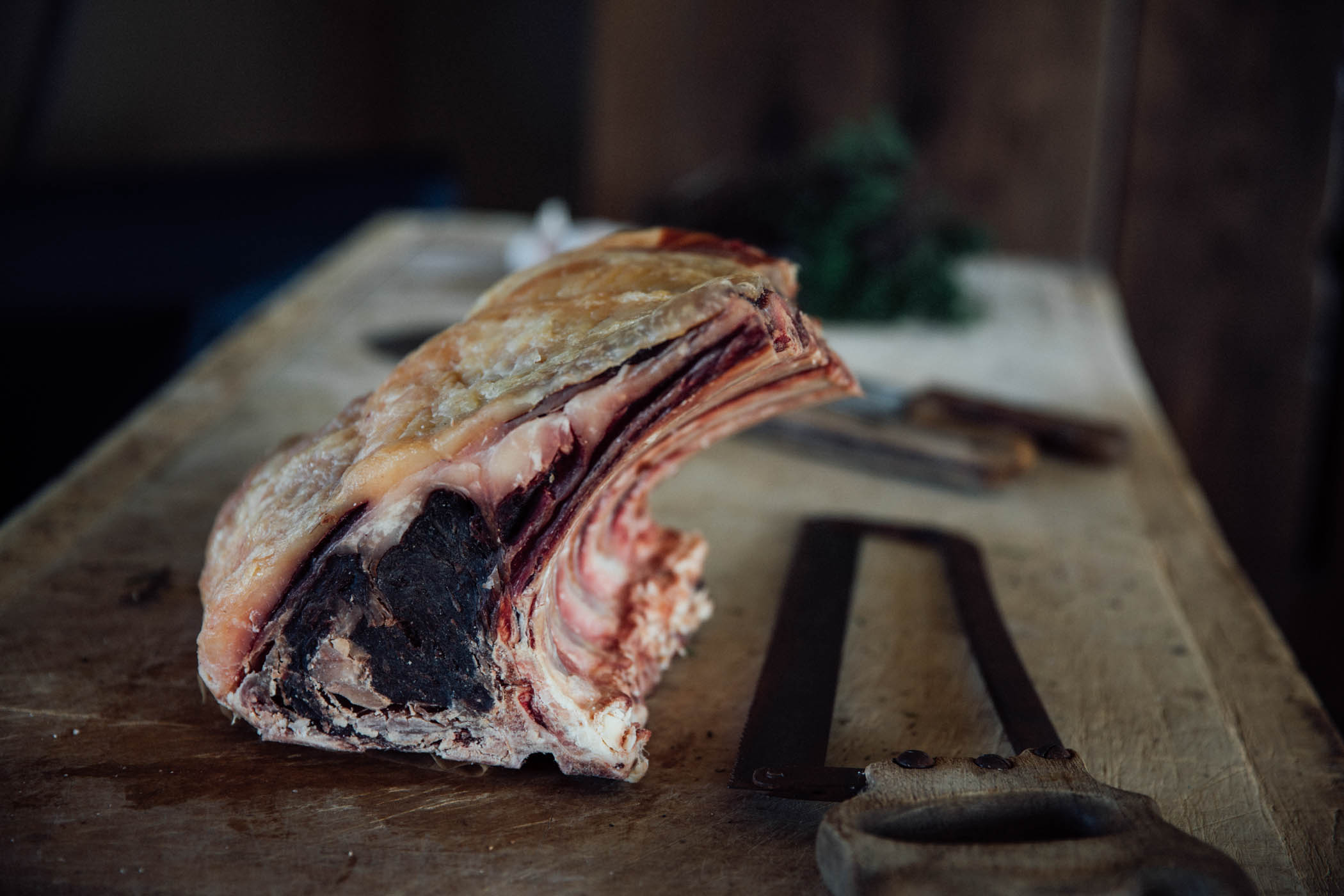
What is a rib of beef?
Perfect for a family celebration or extra-special Christmas dinner, this cut of meat is taken from the primal rib. Not only does its appearance whet the appetite of onlookers, the meat is rich and textured, and most importantly, unbelievably tasty.
Also known as a standing rib roast, a rib of beef is usually roasted on the bone to give the outer layer of fat a crackling golden crust. It’s large fat ‘cap’ offers perfect natural basting during the cooking process, keeping the meat moist for a tender, succulent roast.
Roast rib of beef cooking time
After a quick blast in a hot oven for 15 minutes (this accelerates the browning process and gets the caramelisation of the surface on its way), we recommend cooking your rib of beef for 20 minutes per 500g for medium-rare doneness.
Typically, prime rib is considered best served medium-rare for optimal flavour and texture, but you can cook it to your preference using a Meater thermometer. For a rarer or more medium result, reduce or increase the timings by 4-5 minutes per 500g.
You can also roast your rib of beef at a very low temperature. Cooking it low and slow will take a minimum of four hours, but this will vary depending on the size of your beef joint. It’s a great way to achieve that perfect medium-rare cook, ensuring the meat remains tender and juicy, while still having a velvety texture.
A meat thermometer reading of 53-55ºC is ideal for medium-rare, 49-51ºC for rare and 57-59ºC for medium.
Best way to cook a rib of beef
Traditional roasting technique
- Remove your rib of beef from the vacuum packaging and pat dry with kitchen paper. Allow it to come up to room temperature.
- Preheat the oven to 220ºC/Fan 200ºC/Gas 7.
- Rub a little oil into the joint (this gives a better surface for salt and pepper to adhere to) – give the joint a generous seasoning with pepper and good quality sea salt. A little tip here is to rub the external fat with English mustard powder so that it cooks to a lovely golden crust, as well as adding a welcome punch of flavour.
- Arrange a trivet of beef bones and chopped onion, carrot and celery – pop the meat onto these in a heavy, good quality roasting tray.
- Give the beef a 15 minute sizzle in the hot oven, then turn the oven down to 145ºC/Fan/Gas 3. From this point on, you need to monitor the cooking of the joint in adherence to the times stated above.
- Baste the joint a few times as it roasts.
- Check to see if the meat is cooked to your liking (see top tips) before removing from the oven to rest.
- Remove from the oven and rest uncovered for 10 minutes, before loosely covering with foil to keep it warm. Allow it to rest for at least another hour so that the juices become more evenly distributed.
- To make a gravy place the roasting tray on direct heat, scraping all the browned bits and sediment from the base of the pan, add around 500ml of beef or chicken stock, reduce to your desired texture and sieve away the bones and vegetables. A knob of cold butter whisked in at this stage will give an enhanced gloss to the gravy and an added richness.
- Slice the meat away from the bone. Our classic rib of beef is chined to make carving a simple task.
Low temperature roasting technique
This method will result in uniform cooking and a more moist result compared to traditional roasting. When cooking with a large piece of meat such as a prime rib (especially in this way), a meat thermometer is your best friend.
- Remove your rib of beef from the vacuum packaging and pat dry any moisture. Allow it to come up to room temperature.
- Set your oven to 65ºC — this is very low and, if using a gas cooker, the pilot light may be sufficient. This technique will still work at a slightly hotter temperature if necessary, although this will impact timings.
- Rub the rib of beef with a little oil and season generously with sea salt and black pepper.
- Depending on joint size, roasting is likely to take a minimum of 5-6 hours. Aim for 49-51ºC for rare, 53-55ºC for medium-rare, 57-59ºC for medium.
- Rest for a minimum of 20-30 minutes, loosely covered in foil. You can reach this stage up to an hour before serving.
- Ten minutes before you wish to serve the beef, place the joint into the oven at its highest setting.
- Roast for 10-12 minutes until a well-roasted appearance is achieved – this brief roast will ensure the outside is perfectly caramelised, while ensuring internally that the joint does not overcook and become dry.
- Carve against the grain into thin slices (between ½ and ¾ inches thickness).
Top tips
- Make sure to allow plenty of time for the joint to come up to room temperature before cooking. It is really essential for a large joint like this, particularly when cooking it on the bone.
- A check you can do to ensure your meat is beautifully pink is to push a skewer through the thickest part of the joint and leave it for 10 seconds. Take the skewer out and touch it to your inner wrist; it will be warm for medium-rare.
- It is essential to rest a joint like this properly. Once removed from the oven, the residual heat in the joint needs plenty of time to evenly distribute through the meat, whilst the flesh itself has the chance to relax properly. If you are impatient with the resting of the joint, I’m afraid you will not get the best out of this joint.
Roast rib of beef recipe
For those looking to eschew the more traditional roast dinner garnishes, try our Roast rib of beef with baked onions in parmesan and cream — a dish full of aplomb and sophistication.
